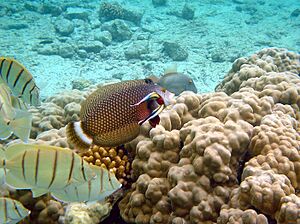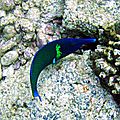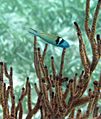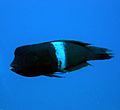Wrasse facts for kids
Quick facts for kids Wrasses |
|
|---|---|
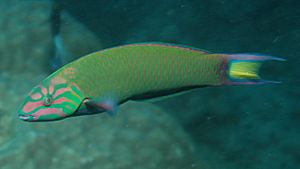 |
|
| Moon wrasse, Thalassoma lunare, a typical wrasse | |
| Scientific classification | |
| Kingdom: | |
| Phylum: | |
| Class: | |
| Order: | |
| Suborder: |
Labroidei
|
| Family: |
Labridae
Cuvier, 1816
|
| Genera | |
|
See text. |
|
Wrasses are a group of colorful ocean fish. They belong to a family called Labridae. There are more than 600 different kinds, or species, of wrasses!
Most wrasses are small, usually less than 20 centimeters (about 8 inches) long. But the biggest one, the Humphead wrasse, can grow up to 2.5 meters (over 8 feet) long! That's like a small car!
Contents
What Do Wrasses Eat?
Wrasses are good hunters. They are carnivores, which means they eat meat. They mostly feed on small animals without backbones, like tiny crabs, snails, and worms.
Some smaller wrasses are clever. They follow bigger fish as they swim along. When the larger fish stir up the sand or rocks, the wrasses quickly grab any small creatures that get uncovered.
Wrasse Mouths and Fins
Wrasses have special mouths. They can push their jaws forward to grab food. Their teeth often stick out a bit.
Many wrasses have thick lips. The inside of these lips has interesting folds. This is why their German name, Lippfische, means "lip-fish."
Their top fin, called the dorsal fin, runs along most of their back. It has between 8 and 21 stiff spines and 6 to 21 soft rays.
Wrasse Life and Changes
Wrasses can look different depending on if they are male or female. This is called being sexually dimorphic.
Many wrasse species can even change their sex during their lives! When they are young, they can be either male or female. These are called "Initial Phase" (IP) individuals. But as they grow older and become the largest adults, they often turn into males that hold their own territory. These are called "Terminal Phase" (TP) males.
The name "wrasse" comes from an old word. It comes from the Cornish language, which got it from the Welsh word gwrach. This word means an old woman or a hag.
Images for kids
-
Giant Napoleon wrasse Cheilinus undulatus in Apo Reef, Philippines
-
Humphead wrasse, Cheilinus undulatus, Melbourne Aquarium
-
Yellowtail wrasse, Coris gaimard, Hawaii
-
A yellowtail coris wrasse, Coris gaimard, is being cleaned by Labroides phthirophagus in Hawaii.
-
Bird wrasse, Gomphosus varius, Kona (Hawaii)
-
Gomphosus caeruleus swimming with a yellow goatfish
-
Bluehead wrasse, Belize Barrier Reef
-
Clown wrasse, Coris aygula, Red Sea
-
Pearl wrasse, Anampses cuvieri, Hawaii
-
Bluestreak wrasse, Labroides dimidiatus
-
Six-line wrasse , Pseudocheilinus hexataenia
See also
 In Spanish: Labridae para niños
In Spanish: Labridae para niños


